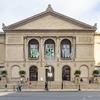More about Bar-room Scene

Sr. Contributor
Ah, the drunk guy dancing in a bar; it just wouldn’t be a Saturday night in William Sidney Mount's hometown of Stonybrook, Long Island without one.
Mount excelled at painting genre scenes that often took place in Stonybrook, and were probably at least somewhat accurate in their depictions of life there at the time. This painting, in the collection of the Art Institute of Chicago, was originally called The Breakdown; the title was likely changed in the late 1990s.
The original title is kind of cryptic. It may have been a simple reference to the dancing man (breaking it down?) or possibly something more. During the period of time that Mount painted this, there was discussion in some circles of the “breakdown” of societal leisure and family norms, due to the rising influence of an industrialized society, at least in the smaller towns. Mount regularly spent time in New York City, and experienced firsthand what one author describes as “…the destruction of traditional village or community culture, where leisure customs were lost”
One thing that is glaringly obvious about the dancing man, other than the fact that he’s the only one turned away from the viewer, is the condition of his clothes; this poor man is definitely down on his luck and going through some rough times. All of the other figures in the painting are dressed pretty well, including the young boy and the African American man standing off to the side. Maybe the other people are mocking the drunk, or maybe they’re just having a good time as well. Although, with the exception of the man clapping and the boy, the others look like they’re just tolerating him, as you do with some people in a bar-room setting.
Mount often included African American people in his work, and while they were portrayed with dignity, and as individuals instead of a stereotype (which was all too common at the time), they were usually still shown on the periphery of the main scene, as in The Power of Music, and certainly in Bar-room Scene. While the young Black man looks like he’s enjoying the dancing guy, he’s definitely not a part of the party, and the others probably aren’t even aware of his presence. The Black man also fits the description of what has been called “Mount’s Mysterious Strangers,” where one of the people in the scene stands apart from everyone else, sometimes with their face hidden, as in The Raffle (Raffling for the Goose), at the Metropolitan Museum of Art.
The way Mount painted the African Americans in his scenes may also have had something to do with his clients; the people who bought his paintings were overwhelmingly white men who were at least well-off, or just plain wealthy. He might have thought he needed to strike a balance in his work in order to keep his patrons happy, being careful to choose subjects that appealed to the majority of people. He himself stated: “Paint pictures that will take with the public, in other words, never paint for the few, but for the many.”
Mount painted a couple of other scenes in taverns, such as The Tough Story - Scene in a Country Tavern, which contains another bar patron stereotype: the person who just talks too much. Some things never change…
Sources
- Adams, Karen M. "The Black Image in the Paintings of William Sidney Mount." American Art Journal 7, no. 2 (1975): 42-59. doi:10.2307/1593998.
- Faulstich , J. S. (1996, July). Eight Hours Between Work and Sleep: Research and Curriculum Development Based on the Concept of Leisure Found in Nineteenth-Century Genre and Still Life Painting. Cardinal Scholar. https://cardinalscholar.bsu.edu/bitstream/handle/handle/190283/F38_1996….
- Frankenstein, Alfred V., and William Sidney Mount. Painter of Rural America: William Sidney Mount, 1807-1868. Washington, D.C.: Printed by H.K. Press, 1968.
- Mount, William Sidney, and Alfred Victor Frankenstein. William Sydney Mount. New York: Abrams, 1975.
- Oedel, William T., and Todd S. Gernes. ""The Painter's Triumph": William Sidney Mount and the Formation of a Middle-Class Art." Winterthur Portfolio 23, no. 2/3 (1988): 111-27.
- The Art Institute of Chicago. Bar-room Scene | The Art Institute of Chicago. (n.d.). https://archive.artic.edu/casewine/artwork/30709.
- Weinberg, H. Barbara, and Carrie Rebora Barratt. American Stories: Paintings of Everyday Life, 1765-1915. New Haven, CT: Yale University Press, 2009.











